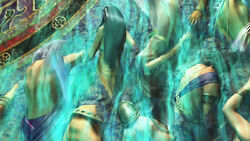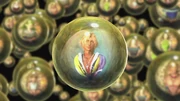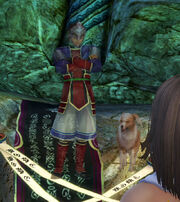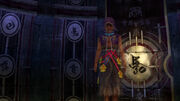
The fayth summoning the Dream Zanarkand.
Lulu: The fayth are people who gave their lives to battle Sin. Yevon took their souls, willingly given from their still-living bodies.Tidus: Huh?Lulu: Now they live forever, trapped in statues. But when a summoner beckons, the souls of the fayth emerge once again. That's what we call an aeon.Lulu explains fayth to Tidus.
The fayth (祈り子, Inorigo?, lit. Child of Prayer) are humans who willingly had their souls sealed in statues in a state of dreaming in Final Fantasy X. Their powers allow a summoner to coalesce the power of pyreflies to create physical forms called aeons or other magical phenomena. In the world of Spira the fayth are the souls of the people who willingly underwent a ritual that removed their souls from their still-living bodies and sealed into stone tablets. This technique of creating fayth is known only by those from Zanarkand.
Story
Final Fantasy X
Template:Sideicon

Tidus and the other people of the Dream Zanarkand being summoned by the Fayth.
After Zanarkand's defeat at the hands of Bevelle, Yu Yevon, the ruler of Zanarkand, converted those of his people still alive into fayth and placed them on a wall on Mt. Gagazet and used these new fayth to summon a dream world modeled after Zanarkand. With the power of the fayth's dream, he summoned all of the buildings and all of the people who had lived there to "preserve" Zanarkand for all time. After this Yu Yevon summoned an armor around himself and created Sin.
Yevon's daughter, Lady Yunalesca, and her husband, Lord Zaon, went to Bevelle with a means to stop Sin. Yunalesca made Zaon into fayth to summon a powerful aeon, known as the "Final Aeon", for the first Final Summoning. Although she and Zaon defeated Sin, Yunalesca died and the spirit of Yu Yevon possessed Zaon's aeon body, turning it into a new Sin.
The fayth's aeon forms are the physical embodiment of the fayth itself. For example, Anima's fayth is Seymour's mother whose suffering created Anima; aeons usually embody the fayth's strongest emotion, in Anima's case pain and sorrow.
Yunalesca remains in the world of the living at the ruins of Zanarkand as an unsent and awaits the summoner who makes it to her abode to create the Final Aeon from the summoner's guardian. If the summoner defeats Sin using the Final Aeon, the fayth within Sin is allowed to rest as Yevon jumps to the body of the Final Aeon, creating a new Sin, and enters a recuperative state; this time during which Sin is absent is called "the Calm". To ensure the summoner's readiness, they embark in a pilgrimage to visit the Yevon Temples around Spira to pray for their fayth and acquire the power to summon them as aeons.
The fayth grow tired of a millennium of dreaming and request Tidus, a person who hails from dream Zanarkand and thus a product of their dream, to destroy Yu Yevon so they can rest. After Yu Yevon's defeat the fayth are freed to enter the Farplane, but Tidus and his world disappear alongside them.
Final Fantasy X-2
Template:Sideicon It is revealed the fayth who had sacrificed themselves to help Yuna defeat Yu Yevon, had become enslaved by Shuyin's darkness. During her journey to the Farplane Yuna meets Bahamut's fayth who tells Yuna about Shuyin and how the fayth tried to stop him but were unable to. Yuna and her friends free the fayth from Shuyin's influence by defeating him, and at the end of her journey Bahamut's fayth appears to Yuna and asks if she would want to see Tidus again. If Yuna wills it, the fayth gather Tidus's pyreflies into a corporeal body and send him back to Spira to reunite with Yuna.
Known Fayth

Yojimbo's fayth, a man and his dog, tell Tidus that Spira will not forget its savior.
Each fayth has two physical forms (not counting the aeon form): The spirit-like fayth, and its soul form, sealed in a stone tablet.
- Zaon: The fayth of the first Final Aeon. Though he is only referenced in Final Fantasy X, he reappears in the depths of Via Infinito in Final Fantasy X-2. Apparently, his aeon form became a fiend called Paragon.
- Fayth of Bahamut: A child-like fayth who watched Tidus grow up in dream Zanarkand. Stationed at Bevelle Temple, he is the one who brought Tidus and Yuna together so the fayth can end their dreaming. Two years later, when the Gullwings defeat Anima, the last aeon twisted by Shuyin, Bahamut's fayth appears to the girls to apologize on behalf of the other aeons for attacking them and explaining why they did so. Bahamut's fayth acts as a representative for all fayth; except for Seymour's mother, Jecht and Zaon, Bahamut's fayth is one of only two original designs and not a reused model for NPCs. The halo behind Bahamut's head is present on the hood of the fayth's clothing.
- Fayth of Valefor: A young girl who lived at Besaid.
- Fayth of Ifrit: A male Crusader who was stationed at Kilika Temple. His character model is reused throughout the game, as well as for the Final Fantasy X-2 NPC Yaibal.
- Fayth of Ixion: A man dressed in clothes from the seas who was stationed at the Djose Temple.
- Fayth of Shiva: She was a Macalanian priestess prior to becoming the fayth for her temple.
- Fayth of Anima: Seymour's mother, a tortured soul who suffers because her son, Seymour, only became power-hungry after receiving the power of Anima from her fayth. She was stationed at Baaj. Her fayth design is one of the only ones not to be used by another NPC.
- Fayth of Yojimbo: A bodyguard in life, he was stolen from a temple to hinder the summoners' path. He ended up in what came to be known as the Cavern of the Stolen Fayth. His only companion is a dog named Daigoro. His is a reused model for Crusaders, and blitzball free agent player Kyou and the Final Fantasy X-2 NPC Beclem.
- Fayth of the Magus Sisters: The three sisters became the fayth of Remiem Temple, though it is rarely visited due to its out-of-the-way location.
- Jecht: Tidus's father, the fayth of Lord Braska's Final Aeon.
Several aeonic forms have different names (for example Grothia, the name for Isaaru's Ifrit), implying they are identical in appearance but separate in nature from the other aeons of similar form.
Creation
Lady Yunalesca is the only one described by Final Fantasy X as having created the fayth after her father converted the Zanarkand residents into fayth 1,000 years ago. She created the fayth of the temples every summoner party visits before reaching Zanarkand to aid them in preparation for the Final Summoning. The summoner's guardian willingly becomes the Final Aeon's fayth, who then becomes a vessel for Sin once Yu Yevon enters the Final Aeon, using its form to build a new Sin. After the new Sin is defeated the fayth is free to enter the Farplane. The only exception would be Zaon, the first Final Aeon, who resides at the bottom of Via Infinito underneath Bevelle.
The fayth predate the Zanarkand war, since Zanarkand was the long-time home of the summoners. Summoners summon aeons, which are themselves associated with individual fayth. The "Dream of the Fayth" is a different manifestation performed by the fayth created from the Zanarkand survivors who allowed Yu Yevon to make them into fayth. Therefore, since summoners existed long enough before the Bevelle-Zanarkand War to make Zanarkand their city, they must have possessed the knowledge to create fayth. It is to be assumed the fayth are at least as old as the existence of summoning itself; another great unknown is what exactly it takes to become a fayth.

Bahamut's fayth personification.
The fayth are different from spirits as they are in a state of dreaming, tied to Spira because of Yu Yevon and even after departing for the Farplane their aeons could be used in Spira by Shuyin. Tidus was conscious enough on the Farplane to whistle at Yuna when she was there, so it is possible that Farplane dead merely have a different type of consciousness.
There seem to be different levels of fayth. Bahamut's fayth acts as a 'emissary of the fayth' for Tidus in his dreams or in dream Zanarkand, and the remaining ten fayth only appear in a temple's Chamber of the Fayth. The hundreds of fayth gathered in the fayth spring near Zanarkand are never communicated with.
Gallery
Template:Gallery
Etymology and Symbolism
"Fayth" is an obsolete spelling of the English word, "faith". It is strongly believed to be an intentional use, giving religious undertones to the fayth, who are referred to as "children of prayer" in the Japanese.
The Siddham Sanskrit script, which is the basis for the script of Yevon in Final Fantasy X, is used in Japan mostly by the Shingon School of Buddhism that draws on early Hindu traditions. One traditional concept is that deities manifest their thoughts or spiritual energy in the physical world on several different "wavelengths": Sound, Form, and Symbol. The form through which a deity can manifest is an anthropomorphic representation that is not the deity itself, but a living form humans can apprehend. The form physically expresses the deity's essence, in the same vein the aeons represent the fayth's dreams rather than their temporal bodies. In some Hindu and Buddhist practices one can invoke a deity through the physical representation of a statue, similar to the link between aeons and fayth. The fayth also sing the "Hymn of the Fayth", which may represent the "Sound" part of the different ways deities manifest in the physical realm in Shingon School of Buddhism.
See Also
Template:FFX
